Tips and Articles
All the king’s men
Updated: 2010-12-03 14:02
By Chitralekha Basu (China Daily European Weekly)
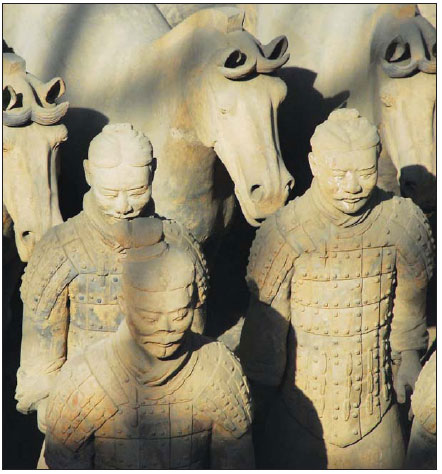 |
|
Terracotta horses and warriors in Xi'an of Northwest China's |
Nothing compares with seeing Shaanxi province’s hottest tourist draw in person, but Advance reading helps.
There can be no debate about whether it is worth traveling all the way to Xi'an, Shaanxi province, to have a look at the army of terracotta men, up close. Or, in this case, down below. The life-size statues, intricately coiffed and strapped up in full battle gear, created, ostensibly, at the behest of the First Emperor of China, Qin Shi Huang (259-210 BC), are displayed in the pits in which they were found, since 1974 ?a level down from the viewing area. About a thousand of them stand in battle formation, lined up in the 11 tunnels in Pit 1, punctuated by horse-drawn chariots (except that the chariots, made of wood, have long turned to dust, only their imprint on clay remains). The closest one can get to discerning if a figure in question is wearing a knife hung from his belt or a smirk on his face is by looking through a telephoto lens. Most visitors who land up in Lintong, about 40 km northeast of downtown Xi'an, at the site of the terracotta army museum ?which, after the Great Wall, remains China's most-favored tourist destination ?have already been exposed to telling images of the emperor's men. There is a range of very fine books in English ?including exhaustive and meticulously illustrated accounts of the excavation and restoration of the terracotta warriors, busting a few myths about the First Emperor that have sprouted and sustained themselves, filling up the space created by the paucity of historical records. Here's our pick.
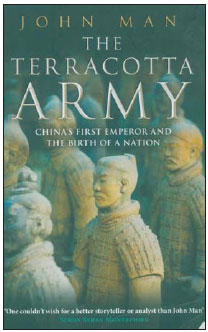
The Terracotta Army: China's First Emperor and the Birth of a Nation, by John Man
2007, reprint 2009, Bantam Press, London
John Man's racy retelling of the Qin Emperor's story often feels like watching a high-octane Peking Opera, complete with tales of illicit love, betrayal and intrigue. Based as it is, primarily, on Han Dynasty (206 BC - AD 220) scribe Sima Qian's Records of the Grand Historian, Man keeps questioning Sima's motives for showing the First Emperor up as one of the most ruthless tyrants, a megalomaniac driven by expansionist ambitions who mass-executed Confucian scholars and burnt books to annihilate the possibility of dissent.
As Man reconstructs the story of how Ying Zheng, a prince of the Qin Dukedom, rose to power - including the bizarre details about how his chief counsel, the merchant-turned-kingmaker, Lu Buwei, who was probably also his father, carried on a clandestine romance with his mother, even as he would send other men, disguised as eunuchs, to cater to her needs - he points out that Sima might have been exaggerating, as it was a standard practice among ancient Chinese historians to launch a smear campaign against a ruler from the past as a veiled attempt to criticize one's own (in this case Emperor Wudi of the Western Han Dynasty, 140-87 BC).
Man's work could well double as a handy, comprehensive guide to the terracotta army museum. It gives the reader a complete sense of context, right from the accidental discovery of the site in 1974 by local farmers digging to find a well, to details about the well-oiled reproduction industry, thriving on export of mass-produced models of Qin cavalrymen.
Man also weaves in his personal journey across terracotta terrain. Meeting local archaeologist Zhao Kangmin, for instance. Zhao managed to save the first few finds from being vandalized by the soldiers of the "cultural revolution" (1966-1976) who would have destroyed anything resembling an ancient deity. He also describes his engagement with restorers who showed him how they tried to preserve the chipped lacquer on a soldier's armor and made bronze cranes with withered legs stand again.
The greatest achievement of this book is the way Man is able to read a 2,200-year-old creation in the context of the history that followed, finding resonances of the First Emperor's "inspirational, authoritarian, nation-building" impulses in Mao Zedong. Like the Great Wall, Man contends, the Terracotta Army "states two grand themes of Chinese history: Geographical unity and continuity".
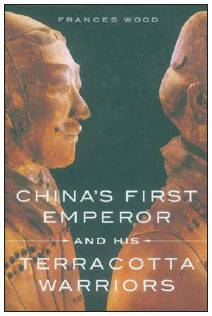
China's First Emperor and his Terracotta Warriors,by Frances Wood
2008, St. Martin's Press, New York
Frances Wood, who heads the Chinese section in the British Library, has tried brushing the cobwebs off some of the huge scandals that have stuck to the larger-than-life figure of the First Emperor for 2,000 years - the two most notorious among these being the mass-incineration of scholarly texts and killing 460 Confucian scholars.
The virtues advocated by the legendary public intellectual and thinker, Confucius (551-479 BC) - especially his ideas about universal brotherhood, abstinence from war, engagement with music, poetry and history - were seen as "parasitical and inimical to the military and agricultural success of the state" by 4th-century BC Qin Prime Minister Lord Shang Yang, whose views were endorsed by the First Emperor. The execution of scholars during the reign of Qin Shi Huang became an oft-repeated theme in 18th-century miniature painting, perpetuating the myth of his being a ruthless barbarian.
But the First Emperor may not have been as much of an anti-cultural philistine he is made out to be, Wood argues. The man, to whom we must credit standardizing the written Chinese script, did not order a wholesale burning of books, only those deemed to be "compilations of didactic historical anecdotes" by his councilor, Zhao Gao, who was also instrumental in executing the scholars who resisted such desecration of the written word, Wood writes.
The written word was definitely not anathema to the Emperor who would stay up late to read through a daily quota of 30 kg of official documents - inscribed on rolls of bamboo shafts - according to Sima Qian. Safeguarding and promoting the interests of a kingdom he had worked so hard to achieve was his primary goal, and the Terracotta Army, as Wood points out, was "an industrious rather than an artistic project" - an emblem reflective of Qin power and glory.
Experts point out that there are only two types of hand forms found among the 16,000 specimens unearthed so far, only their placing at different angles in combination with different costumes adds the illusion of individuality. "It is the most extraordinary example of creative mass production in the world."
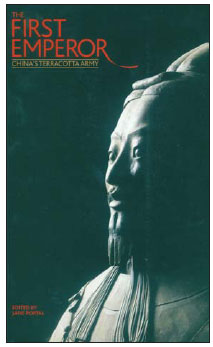
The First Emperor:China's Terracotta Army,by Jane Portal (ed)
2010, The British Museum Press
If Xi'an really seems a road too far from where you are, this is probably the book for you. Produced by the British Museum, this is a lavishly-mounted and profusely illustrated catalogue of all the sights one might see in and around the First Emperor's burial area, spread over a jaw-dropping 56 sq km. The images come with keenly observed captions, pointing out details like the length of the armor varying in keeping with the soldier's rank, for instance, or that the headless strongman's bulky stomach is suspended by a broad, functional belt. Only a few would have noticed that the bronze crane lowering its neck has a minuscule fish tucked between its beak. The book highlights these details, adding a well-researched gloss in each case.
It also comes with an excellent selection of articles: including one by editor Jane Portal, who gives an overview of the First Emperor's role in the making of China, commending him for "introducing a centralized bureaucracy and a culture in which writing and merit played an important part". She also marvels at the grand imperial vision, reflected in the construction of the tomb complex - a manifestation of the emperor "being able to see himself as a ruler on a cosmic scale".
The rest of the articles celebrate and question what the eye can see and also conjecture about what still lies beneath.
Specials

President Hu visits the US
President Hu Jintao is on a state visit to the US from Jan 18 to 21.
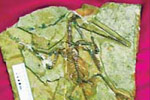
Ancient life
The discovery of the fossile of a female pterosaur nicknamed as Mrs T and her un-laid egg are shedding new light on ancient mysteries.
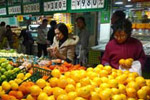
Economic Figures
China's GDP growth jumped 10.3 percent year-on-year in 2010, boosted by a faster-than-expected 9.8 percent expansion in the fourth quarter.